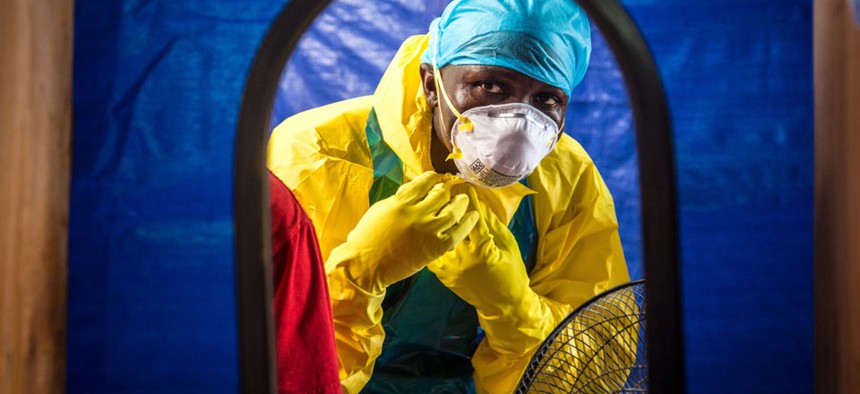In Off-the-Grid West Africa, How Can Tech Fight Ebola?

A healthcare worker dons protective gear before entering an Ebola treatment center in the west of Freetown, Sierra Leone. Michael Duff/AP File Photo
For now, a big piece of USAID’s efforts lie in improving the technology doctors and nurses use when treating patients with Ebola.
Leveraging technology to combat Ebola in West Africa was always going to be an uphill fight.
“You have very little cellphone coverage,” said Steven VanRoekel, chief innovation officer at the U.S. Agency for International Development. “You have unreliable power everywhere. Devices you would want to put out to the field probably can’t connect to the Internet.”
Health care workers trying to communicate with each can wait for as long as 24 hours for a single text message to inch across 2G cell networks, he said.
“We hear stories about people climbing to the top of an anthill or a tree and holding their phone up so they can get data downloaded on it, and then they go down and they can send an email,” he said.
So, suffice it to say, VanRoekel, the administration’s point-man in using technology in response to the outbreak, is clear-eyed about the challenges he faces in his job.
“The key here is that technology is not the solution to Ebola,” VanRoekel, said Thursday at a Washington, D.C., event hosted by FedScoop.
Instead, the former federal chief information officer is asking, “What can technology do … to help us make better, faster decisions -- to get our arms around this in a way we wouldn’t be able to without technology’s help?”
USAID Wants to Give Doctors Better Tech
For now, a big piece of USAID’s efforts lie in improving the technology doctors and nurses use when treating patients with Ebola.
For example, widespread use of tablets and other devices at Ebola treatment centers to track patients’ medical histories has, so far, been limited because there aren’t surefire ways to disinfect commercial electronics.
“You’d have to be able to dip that tablet in chlorine water to get any virulent material that’s on it, off,” VanRoekel said. USAID is now working with providers to offer “ruggedized” tablets.
Another major project is a redesign of the stifling hot and jerry-rigged protective suits health care workers wear when dealing with patients.
For now, the best protection for nurses and doctors treating Ebola patients are hooded suits made out of a light-weight plastic material called Tyvek. Workers have to be sure to cover all seams with medical tape and are then swathed in a rubber apron.
But when fully suited up, workers quickly overheat.
“In a conditioned lab environment in the United States … you can crank the air conditioning,” VanRoekel said. But in West Africa, daytime temperatures can reach 110 degrees with nearly 100 percent humidity. Health workers can typically only last about 30 minutes in the suits “before you start to really cook inside,” he added.
Removing the suit, which typically takes about 30 to 40 minutes, also poses problems.
“Taking the suit off is one of the most dangerous things you can do,” he said; health workers risk infecting themselves if virulent material remains on the exterior of the suit.
Under Armour May Have the Solution to the Suit Problem
A few weeks ago, USAID hosted a “maker faire,” which brought together traditional medical apparel manufacturers, such as Kimberly Clark and 3M, with sports clothier Under Armour and a company that produces cooling vests for racecar drivers.
“If we bring these two worlds together and have them sit around tables for two days, what can we get out of that as far as re-imagining the suit,” VanRoekel said.
Among the ideas generated were positioning seams in the back of the suits and including special tabs on zippers to make them easier to remove without actually touching their exteriors.
A few weeks prior, the agency launched an “Ebola Grand Challenge” on the OpenIDEO online platform to come up with other ways to improve the protective equipment.
“In the next week or so, we’re going to have a ‘bake-off’ where people come in and present their ideas and have a panel of health judges tell us what the best ideas are,” VanRoekel said.
Finding more ways to collect data -- and more uses for it -- is also a key element of USAID’s tech plan.
“Right now, we have a lot of people collecting data but don’t have a lot of visibility into what that data is telling us on the ground,” VanRoekel said.
With better coordination, that data can be used in modeling and other big-data exercises.
“This is taking cellphone records and climate data and population maps and layering them on top of each other to really learn more about the way disease moves through a country,” he said. “Can we predict movement in a way that would tell us where to build that next treatment unit or deploy a front team?”
NEXT STORY: How Micro-Targeting Helped GOP Mobilize Voters


